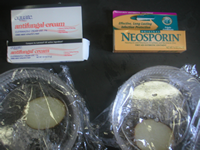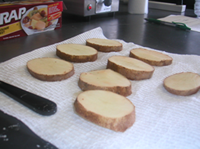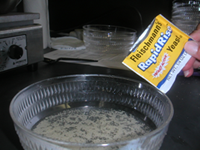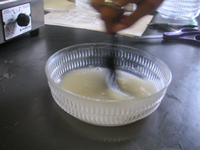
Cell Culture is a technique used to grow and identify microorganisms that are found in our environment.
Age Appropriateness
10-14 years old
INTRODUCTION
What is a Cell Culture?
Cell Culture is a technique used to grow and identify microorganisms that are found in our environment. Microorganisms are among the most abundant and diverse organisms on the planet, but they are so small that they cannot be seen! As their name implies these simple organisms are so small that they can only be seen using a microscope. Some types of microorganisms that you may be familiar with are bacteria, viruses and fungi. They are the cause of most types of infection and some diseases.
In order to study such small beings, scientists have developed ways to grow large quantities of microorganisms through a method called cell culture. In cell cultures, microorganisms are often grown on a special jell-o like substance called agar that has all the nutrients that a microorganism needs to reproduce. Most microorganisms can reproduce in very simple ways, which allows them to reproduce very quickly to form large groups of microorganisms. These large groups of microorganisms are called colonies. Colonies are identical copies of the same original organism and are usually large enough to be seen by the naked eye. In most cases, colonies will look like little circular mounds on the agar. If there are lots of microorganisms in the sample, colonies can sometimes join together to form what is called a lawn.
The following experiment will allow you to explore the field of cell culture using similar techniques that scientists use. Scientists classify different microorganisms based on size, shape and color of the colony. Scientists also examine the effect that different chemicals such as antibiotics and fungicides can have on the cultures to try and identify the specific type of microorganism that is present in the colony. In this experiment the student will use potatoes as a food source for the microorganisms and will be able to observe the growth of samples of bacteria and fungus. The student will also use different over the counter antibiotics and fungicides on the cultures to see their specific effects on both bacteria and fungus. As an extension students can use the same techniques to observe the types of microorganisms that are present in their homes or on their bodies.
In the activity we will:
- Learn about cell culture
- Learn about common bacteria and fungi that live all around us
- Observe the effects of antibiotic, antifungal, antimicrobial and antiseptic products
Materials
- Potatoes
- Multiple small bowls or dishes (preferably disposable)
- Saran wrap
- Butter knife
- Yogurt (live and active culture with the symbol on the right)
- Baking yeast
- Q-tips
- Water
- Antibiotic ointment (such as Neosporin)
- Antifungal cream/spray (Athlete's foot treatment or anything with Miconazole)
- Bleach
Safety
- All procedures should be done under adult supervision
- Even butter knives can be sharp, so be careful
- Do not eat anything created by this experiment
- Wash hands before and after performing the procedures
- When finished with this experiment, bleach all resulting cultures and dispose of immediately to prevent illness
- To avoid contamination use a new q-tip for each step of the procedure, go from sample to potato and not back again
Preparation
 Potatoes
Potatoes
- Cut the potato with a butter knife into 1/4 th inch slices. You will need about 7 slices.
- Boil the potato slices for 4 minutes (this will prevent the potatoes from rotting).
- Place the slices in individual bowls and cover immediately with saran wrap
- Let the potatoes cool for 10 minutes
- Uncover each potato and add a small amount of water to the bottom of the dish being careful not to get any water on the surface of your potato. This will make sure that your potato with stay slightly moist throughout the experiment.
 Yeast Culture
Yeast Culture
- Dissolve a few grains of baker's yeast in a teaspoon of warm water. This will serve as your yeast stock culture.
Bacteria Culture
- Obtain a plain yogurt container with the "live and active cultue" symbol. This symbol means that the yogurt has not been pasteurized, which would kill all the bacteria that were used to create the yogurt.
- Dip a q-tip in the yogurt, and dissolve that small amount of yogurt in a teaspoon of warm water. This will serve as your bacteria stock culture.
 Pre-Activity
Pre-Activity
After you have set up your stock cultures, record your predictions of the following questions-
- How long do you think it will take for you to be able to see microbes start growing on your potatoes?
- What do you think the potato cultures will look like when microorganisms begin to grow?
- What effect do you think antibiotics and antifungal treatments will have on the growth of these cultures? Do you think they will have different effects on yeast compared to bacteria?
Activity
General cell culture activity
- Once the potatoes are cool, remove the saran wrap from three bowls. Set one of the potatoes aside. This one will collect airborne microbes that settle onto the potato slices. Label this bowl as the "control" potato. We will compare the results of all of the other potatoes to this potato.
- Choose another potato. Dip a clean q-tip into your yeast stock and spread a small amount onto the potato slice. A zigzagging motion is better than attempting to cover the whole surface; it will allow you to see results faster. Label this bowl as the "yeast" potato.
- Dip a new q-tip into your yogurt stock and spread a small amount in a zigzagging motion on another potato slice. Label this potato as the "yogurt" potato.
- Cover all three bowls with saran wrap. Be sure not to let the saran wrap touch the surface of your potatoes.
- The colonies will take several days to grow. The potatoes should be stored at room temperature or above. If you have trouble getting the colonies to grow, you may try to raise the temperature by placing them in the warmest area of your house, such as your bathroom or laundry room. Do not store cell culture potatoes in an area where food is prepared.
- Record your observations of what happens on a daily basis. It may take up to a week to see full results.
Experimental activity
- Using a clean q-tip spread a small amount of the bacteria culture in a zigzagging motion onto two slices of a potato.
- n one of the potato slices from the previous step, spread some antibiotic ointment on half the potato. Label the potato as "Bacteria/Antibiotic".
- On another slice spray/spread athlete's foot treatment on half the potato (Note: creams will work much better, however, if using a spray use a q-tip to apply medicine daily for best results). Label this potato as "Bacteria/Antifungal".
- Repeat steps 7-9 with the yeast culture instead of the bacterial culture. Label your potatoes appropriately.
- Observe the results of all the potato slices on a daily basis; it may take several days to observe culture growth.
- After about a week, observe both potatoes. Do the two types of cultures look different? Did they react differently to the two treatments? Do you have any colonies that don't look like the rest? Where do you think these other microbes came from?
Extension Activity
Microbes around your house
- Using the same techniques you learned above, sample areas around your house to see what grows
- Sample areas on your body, such as your mouth, tongue, or hands (try the spaces between your fingers!) before and after cleaning.
- See if you can identify the different organisms as bacteria or yeast based on the results from previous experiments.
- Look at the effects that common household products have on yeast and bacterial cultures such as
- Antiseptic mouth wash
- Antibacterial soap
- Hydrogen peroxide
- House hold cleaners
- Hand sanitizer
- Baking soda (sodium bicarbonate)
- Vinegar
Summary
Cell culture is a very versatile technique used by many laboratories around the world. With techniques similar to the ones used in this activity, lab workers can identify what type of microorganism is causing an infection or illness. Results from these tests can also help to find new products that help prevent the spread of microorganisms.
Resources
http://medmyst.rice.edu/html/lessons/MM-TM2-33.pdf
http://www.disknet.com/indiana_biolab/pagelist.htm
Activity PDF: cell_culture.pdf

